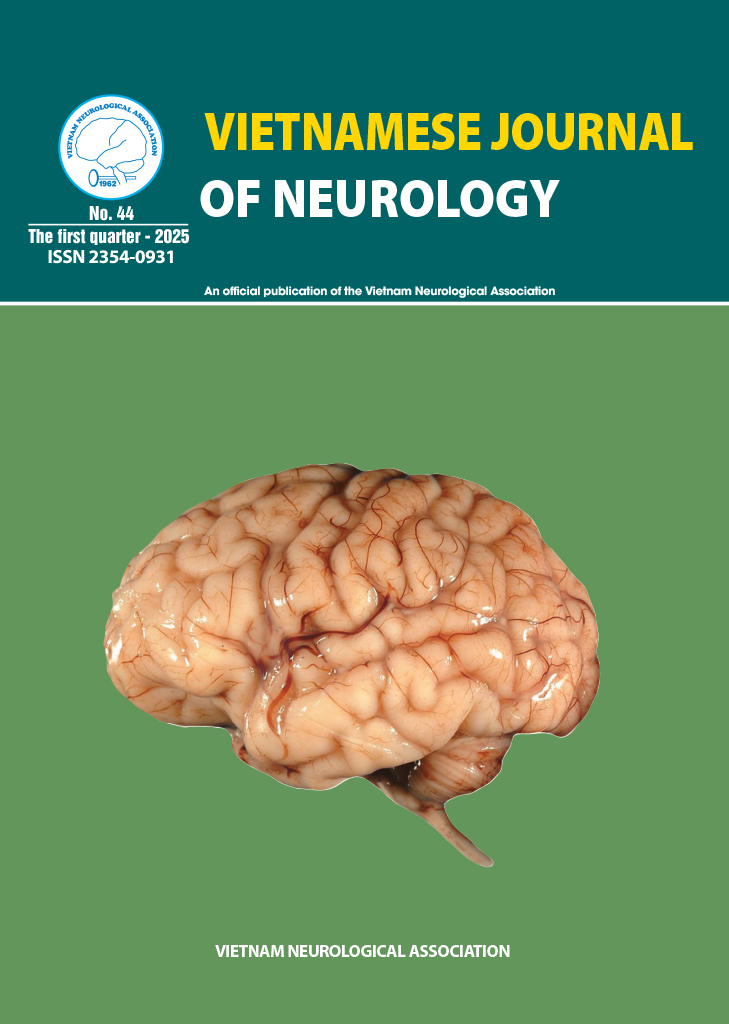Một số yếu tố lâm sàng tiên lượng ở bệnh nhân chảy máu não đồi thị giai đoạn cấp tại Bệnh viện Bạch Mai

DOI:
https://doi.org/10.62511/vjn.44.2025.048Từ khóa:
chảy máu đồi thị đặc điểm lâm sàng tiên lượngLượt tải xuống
Đã xuất bản
Số tạp chí
Chuyên mục
Thể loại
Cách trích dẫn
Tóm tắt
Objectives: Miêu tả một số yếu tố lâm sàng tiên lượng ở bệnh nhân chảy máu não đồi thị giai đoạn cấp tại Bệnh viện Bạch Mai.
Subjects and Methods: Các bệnh nhân chảy máu não đồi thị nguyên phát nhập viện và điều trị tại Trung tâm Thần kinh, Bệnh viện Bạch Mai từ tháng 6 năm 2022 đến tháng 6 năm 2023.
Results: Nhóm tuổi từ 65 trở lên có tỷ lệ bệnh nhân tiến triển tốt chỉ bằng 0,21 lần so với nhóm tuổi dưới 65 trở lên (OR=0,21; 95% CI: 0,1-0,46). Huyết áp tâm thu, huyết áp tâm trương và nhiệt độ cơ thể cao hơn rõ rệt ỏ nhóm bệnh nhân diễn biến xấu ( lần lượt là p = 0.039, p = 0.004, p = 0.002 < 0.05). Tỷ lệ bệnh nhân có điểm Glasgow ≤ 8 khi vào viện tiến triển xấu (86,67%) cao hơn nhiều so với nhóm bệnh nhân có điểm Glasgow > 8 điểm (26,4%). Tỷ lệ bệnh nhân tiến triển xấu trong nhóm liệt nặng (47,76%) cao hơn nhóm liệt nhẹ/ không liệt (19,18%). Nhóm không có bất thường đồng tử tiến triển tốt hơn nhóm có bất thường đồng tử gấp 8,86 lần.
Conclusion: Tuổi, HATT, HATTr, nhiệt độ, Glasgow, mức độ liệt, và bất thường đồng tử là các yếu tố ảnh hưởng tới sự tiến triển của bệnh.
Tài liệu tham khảo
Hemphill JC, Greenberg SM, Anderson CS, et al. Guidelines for the Management of Spontaneous Intracerebral Hemorrhage: A Guideline for Healthcare Professionals From the American Heart Association/ American Stroke Association. Stroke. 2015;46(7):2032-2060.
DOI: https://doi.org/10.1161/STR.0000000000000069

Eslami V, Tahsili-Fahadan P, Rivera-Lara L, et al. Influence of Intracerebral Hemorrhage Location on Outcomes in Patients with Severe Intraventricular Hemorrhage. Stroke. 2019;50(7):1688-1695.
DOI: https://doi.org/10.1161/STROKEAHA.118.024187

Arboix A, Rodríguez-Aguilar R, Oliveres M, Comes E, García-Eroles L, Massons J. Thalamic haemorrhage vs internal capsule-basal ganglia haemorrhage: clinical profile and predictors of in-hospital mortality. BMC Neurol. 2007;7:32.
DOI: https://doi.org/10.1186/1471-2377-7-32

Lee SH, Park KJ, Kang SH, Jung YG, Park JY, Park DH. Prognostic Factors of Clinical Outcomes in Patients with Spontaneous Thalamic Hemorrhage. Med Sci Monit. 2015;21:2638-2646.
DOI: https://doi.org/10.12659/MSM.894132

Nguyễn Minh Hiện, Nguyễn Xuân Thản. Nhận xét các yếu tố tiên lượng nặng ở bệnh nhân chảy máu não. Kỷ yếu công trình khoa học thần kinh. Nhà xuất bản Y học.1996.tr140-143.

Phạm Thị Hải Lý. Đặc điểm lâm sàng, hình ảnh cắt lớp vi tính sọ não và một số yếu tố tiên lượng của chảy máu não bán cầu giai đoạn cấp. Luận văn tốt nghiệp bác sĩ chuyên khoa cấp II, đại học Y Hà Nội. 2019.

Nam TM, Jang JH, Kim SH, Kim KH, Kim YZ. Comparative Analysis of the Patients with Spontaneous Thalamic Hemorrhage with Concurrent Intraventricular Hemorrhage and Those without Intraventricular Hemorrhage. J Korean Med Sci. 2020;36(1):e4.
DOI: https://doi.org/10.3346/jkms.2021.36.e4

Đinh thị Hải Hà. Đặc điểm lâm sàng, hình ảnh cắt lớp vi tính não và một số yếu tố tiên lượng ở bệnh nhân chảy máu đồi thị có máu tràn vào não thất. Tạp chí y dược học lâm sàng 108, số 11/2016, tr.101-106.

Woo D, Comeau ME, Venema SU, et al. Risk Factors Associated With Mortality and Neurologic Disability After Intracerebral Hemorrhage in a Racially and Ethnically Diverse Cohort. JAMA Netw Open. 2022;5(3): e221103.
DOI: https://doi.org/10.1001/jamanetworkopen.2022.1103

Rost NS, Smith EE, Chang Y, et al. Prediction of functional outcome in patients with primary intracerebral hemorrhage: the FUNC score. Stroke. 2008;39(8):2304-2309.
DOI: https://doi.org/10.1161/STROKEAHA.107.512202

Vi Quốc Hoàn, Trần Văn Tuấn. Nghiên cứu đặc điểm lâm sàng, cận lâm sàng và một số yếu tố tiên lượng của chảy máu não bán cầu tại bệnh viện đa khoa trung ương Thái Nguyên. Tạp chí Thần kinh học.2012.tr25-34.

Campos F, Sobrino T, Vieites-Prado A, et al. Hyperthermia in Human Ischemic and Hemorrhagic Stroke: Similar Outcome, Different Mechanisms. PLOS ONE. 2013;8(11):e78429.
DOI: https://doi.org/10.1371/journal.pone.0078429

Iglesias-Rey R, Rodríguez-Yáñez M, Arias S, et al. Inflammation, edema and poor outcome are associated with hyperthermia in hypertensive intracerebral hemorrhages. European Journal of Neurology. 2018;25(9):1161-1168.
DOI: https://doi.org/10.1111/ene.13677

Rincon F, Lyden P, Mayer SA. Relationship between temperature, hematoma growth, and functional outcome after intracerebral hemorrhage. Neurocrit Care. 2013;18(1):45-53.
DOI: https://doi.org/10.1007/s12028-012-9779-9

Fogelholm R, Avikainen S, Murros K. Prognostic value and determinants of first-day mean arterial pressure in spontaneous supratentorial intracerebral hemorrhage. Stroke. 1997;28(7):1396-1400.
DOI: https://doi.org/10.1161/01.STR.28.7.1396

Terayama Y, Tanahashi N, Fukuuchi Y, Gotoh F. Prognostic Value of Admission Blood Pressure in Patients With Intracerebral Hemorrhage. Stroke. 1997;28(6):1185-1188.
DOI: https://doi.org/10.1161/01.STR.28.6.1185

Shah SD, Kalita J, Misra UK, Mandal SK, Srivastava M. Prognostic predictors of thalamic hemorrhage. J Clin Neurosci. 2005;12(5):559-561.
DOI: https://doi.org/10.1016/j.jocn.2004.08.010

Masè G, Zorzon M, Biasutti E, Tasca G, Vitrani B, Cazzato G. Immediate prognosis of primary intracerebral hemorrhage using an easy model for the prediction of survival. Acta Neurol Scand. 1995;91(4):306-309.
DOI: https://doi.org/10.1111/j.1600-0404.1995.tb07011.x










